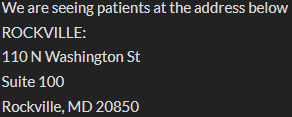Is PRP Bethesda Offers for Me?
 If you are suffering chronic pain caused by an injury or condition, you may have heard about platelet rich plasma (PRP) therapy. Platelets are one component that makes up our blood that is known for both its healing properties and for its blood clotting properties. Platelets also assist in cell growth. The idea behind PRP therapy is that injecting these protein-rich platelets into an injured area accelerates the healing process.
If you are suffering chronic pain caused by an injury or condition, you may have heard about platelet rich plasma (PRP) therapy. Platelets are one component that makes up our blood that is known for both its healing properties and for its blood clotting properties. Platelets also assist in cell growth. The idea behind PRP therapy is that injecting these protein-rich platelets into an injured area accelerates the healing process.
Pain Arthritis Relief Center is a leader in PRP therapy for the Bethesda area and has helped countless numbers of chronic pain sufferers to finally live a pain-free life. Call our clinic today to find out more.
What Type of Conditions Can PRP Therapy Help With?
There are several different types of conditions and injuries that platelet rich plasma therapy can help with. These include:
- Sport and acute injuries: PRP therapy can promote healing in knee sprains, hamstring pulls, and other types of sports and recreational injuries.
- Injuries to tendons: When a tendon is injured, the healing process is often a slow – and painful – one. PRP therapy can help accelerate the healing process for patients who are suffering from Achilles tendonitis, golf and tennis elbow, and patellar tendon pain.
- Osteoarthritis: This condition happens when the cushion (cartilage) that is between the joints disintegrates or breaks down. This leads to swelling, stiffness, and pain. Platelet rich plasma therapy has been shown to be effective in helping to reduce the inflammation and helping alleviate that pain.
- Hair loss: Many patients have had success with hair regrowth after undergoing platelet rich plasma therapy treatments.
- After surgery treatment: Although the goal of PRP therapy is to help avoid surgery, there are cases where surgery is unavoidable, such as the repair of an extremely torn rotator cuff tendon or ACL. Platelet therapy has been shown to be an effective post-surgical treatment because of the way it helps promote healing.
Platelet Rich Plasma Therapy Process
When you come to Pain Arthritis Relief Center for a PRP therapy session, your medical professional will draw a sample of blood, just as blood is drawn for a standard blood test. The blood sample is then placed in a centrifuge which will spin the sample until the platelets are separated from the other components that make up blood, such as red and white blood cells.
The concentrated plasma is then placed in a hypodermic needle and injected into the damaged or inflamed area. Your doctor may use some type of imaging in order to inject the needle into a specific location.
Since the platelet plasma used comes from the patient’s own body, there are minimal risks involved. Some patients do report some discomfort around the injection site, however, this usually goes away within a couple of days after the treatment. In most cases, patients resume their normal activities immediately.
To learn more about PRP Bethesda patients recommend and how it may be able to help with your injury or chronic condition, contact Pain Arthritis Relief Center today for a free consultation.





